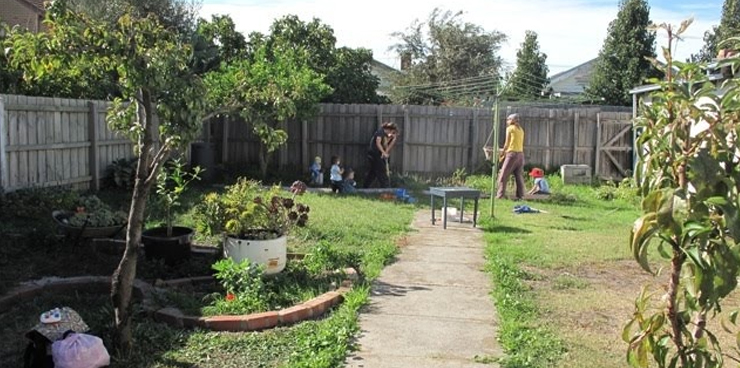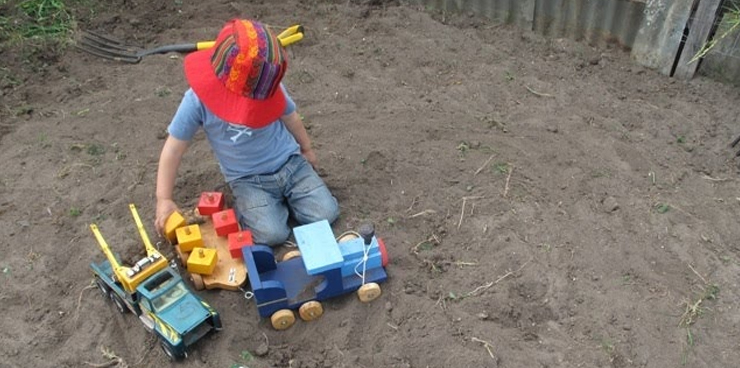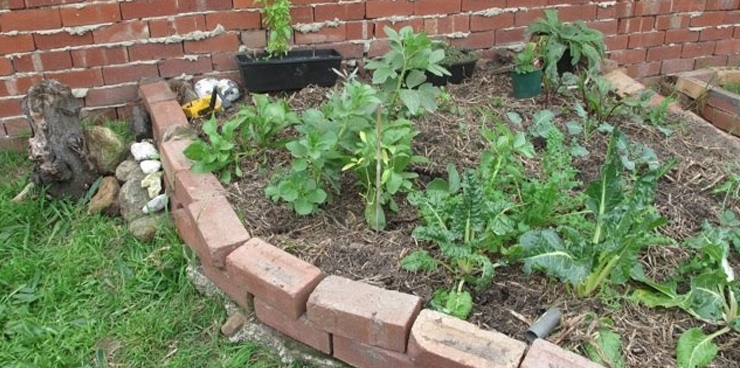
By Nicole Tadpole
I love working in the garden. However when you have limited time and/or small children, sometimes the hard yakka you want to put into gardening is pushed down the list of priorities after changing nappies, making a kite, sticking feathers on a headband, doing the washing, walking to the playground…
So a few years ago my friend Ella and I started a fortnightly gardening group, to get our friends and their kids helping out in each other’s gardens – and finally do some of the things that had been waiting in line behind the nappies and feather headbands. We were also really conscious of how much our children loved helping in the garden, and we thought it would be a great environment for them to meet new friends and learn more about the earth!
Three to seven mums (and one dad) with their kids would usually meet each fortnight for our GROAF (Garden Recreation with Offspring & Friends!). At the beginning not everyone knew each other, but everyone was either a friend of mine, or Ella’s. The children ranged from newborn to five years in age, and everyone mostly lived within a couple of suburbs of each other. Ella’s backyard played host the first time, and we were all so impressed with the amount of work we did (and the new friendships made) that we enthusiastically made a rough schedule for the following fortnights in the rest of the gardens.

What started as a way to get some free labour in the backyard, turned out to be a valued friendship group which, although the fortnightly meetings have ceased, still exits today. Start your own gardening group! Here are some tips you might find useful:
Keep it real!
Be realistic – weekly would be great, but fortnightly or monthly might be more achievable. A couple of hours each meet is probably all you need – we found a 10 or 10.30am start worked because we’d be done in time to get the little ones home for lunch and a sleep.

Set Goals
The goals we had for each garden varied according to the host’s needs. Usually weeding, planting, mulching, and digging were on the agenda. It’s best to keep it simple so you can achieve your goal in the time allocated. Have some tasks for the children to help with too – they love digging, spreading mulch, planting seedlings and seeds, and watering (especially when it’s hot). The garden is a great place for children to practice teamwork, sharing, listening and caring! The host should have a good idea of what needs to be done, and be prepared before the day with mulch, soil, seedlings or whatever is needed. Then when the helpers arrive they can get stuck straight in! No one will feel very productive if the jobs can’t be done due to poor planning. It’s good if people can bring their own tools and gloves, but it helps to have spares handy (some for the kids as well). We also found it’s good for the host to have a few back-up jobs to keep everyone busy in case the work is done super fast!
Reward for effort!
The host would bake something beforehand for everyone to eat with a cuppa when we’d finished. This was a great time to not only to refuel after a decent morning’s work, but a chance to bask in the glory of the progress we’d made (and sometimes to share kid-friendly low sugar recipes!).
No experience necessary
It probably helps if at least a couple of people in the group are pretty garden savvy – but we found that there would be jobs for everybody. If someone’s not particularly good at picking the weeds from the plants, maybe they could dig a hole, or even mind the smaller children for the morning. We really found the old adage to be true: that ‘many hands make light work’, no matter what tasks needed to be done.
The more the merrier
Try and get a good number of people involved (say five) to cover the weeks when not everyone can make it – so you have at least a couple of pairs of hands in the garden. We usually took a break over winter – we found gardening in the warmer months better for the kids.
Make it safe
It’s important to make the garden safe. Things that we take for granted in our own yard with our own children, like a dog behaving nicely or a bit of broken fence everyone walks around, need to be ready for visitors. Put the dog inside for the morning, do a quick inspection around the yard and fix anything that might injure curious little hands. We would also provide a bit of shade for the kids during summer, and somewhere dry for them to play during wet spells.
Sometimes the kids were more interested in playing games with each other than gardening with us – so if possible have other outdoor activities on hand, like outside toys, bikes, a sandpit, cars, painting, colouring, craft etc.

Recycle
Ella was particularly good at gleaning backyard gems from hard rubbish, so the kids would have plenty of push-cars, trikes, dolls, and sandpit toys to play with when they weren’t getting dirty in the dirt. Hard rubbish is also good for things like old bricks and wood for garden bed edging (watch out for old nails and paint though), and wire for fences and tree guards.
Share
A couple of times a year we would all put in and buy a bunch of seedling punnets to divide up and share. This enabled us to diversify our gardens by getting more varieties in the ground – it’s more economical and reduces gluts.
Re-use
We also loved swapping seeds, and we’d keep the pots, seedling punnets and trays for raising seedlings, then we’d share and swap them. The kids loved planting seeds and seeing them sprout!
Above all, enjoy sharing your time in the garden with your children and mates!


